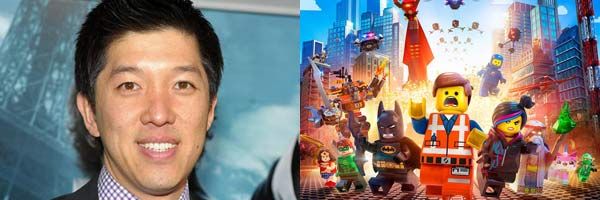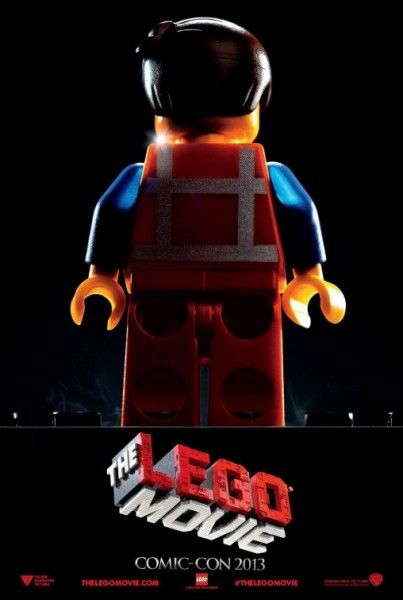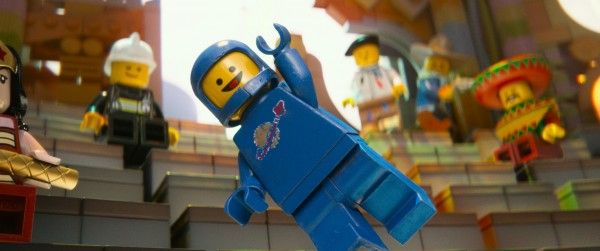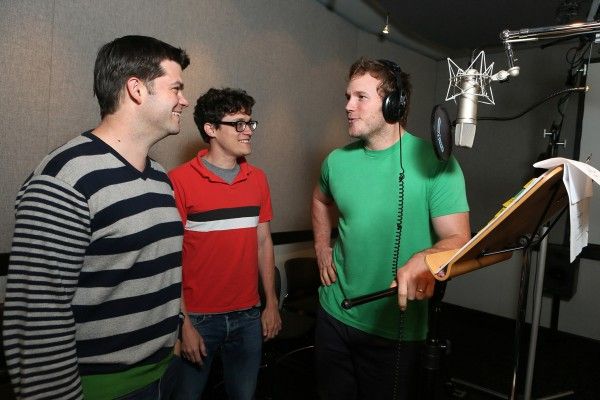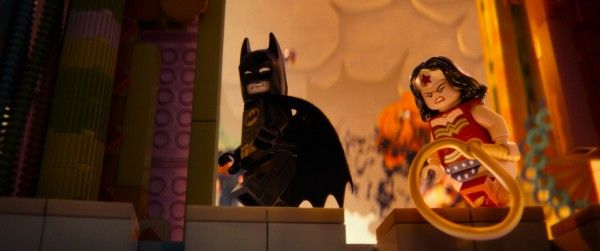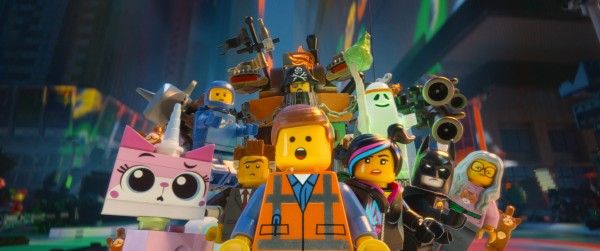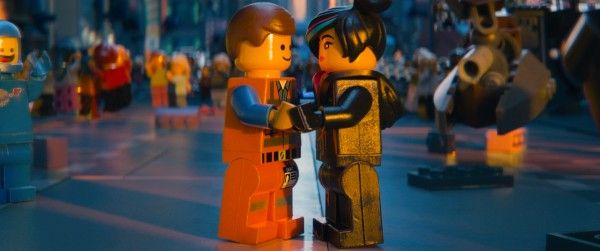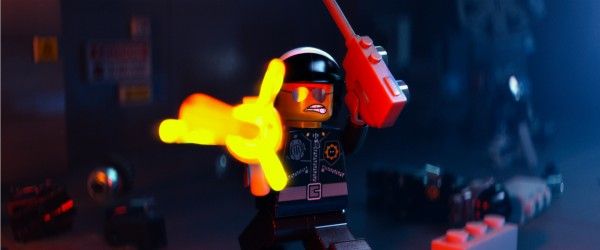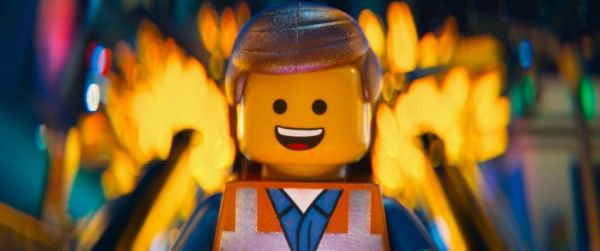As I have said many times, director Phil Lord and Chris Miller's The LEGO Movie exceeded my lofty expectations. Loaded with great animation, a fun story, humor for both kids and adults, and an insanely addictive song (“Everything is Awesome”), The LEGO Movie is truly something special and I strongly recommend checking it out this weekend. If you’re not familiar with the movie, it’s been made using a mix of stop-motion and CG animation and the pic revolves around Emmett (voiced by Chris Pratt), an ordinary construction worker who finds himself anointed “The Special”, a master builder who will lead a band of rebels to save the world from the evil President Business (Will Ferrell). The film also features the voices of Elizabeth Banks, Morgan Freeman, Liam Neeson, Will Arnett, Nick Offerman, Charlie Day, Channing Tatum, Jonah Hill, Alison Brie, and many others.
At the recent press day, I landed an exclusive interview with producer Dan Lin. He talked about how the project came together, LEGO's reaction to the finished film, getting to put Batman, Superman, and other cool characters in the film, the challenge of making it look photo real, how long it might take to get a sequel, what they learned from testing the film, and more. In addition, with Lin producing other projects, I got updates on Sherlock Holmes 3, José Padilha's The Brotherhood, and Cary Fukunaga's adaptation of Stephen King’s It. Hit the jump for what he had to say.
Collider: As I’ve said to you, I love the movie. What is it like having everyone who’s seeing it just love something like this?
DAN LIN: It’s beyond my wildest dreams, to be honest. You know, last week I was in Denmark to show a thousand LEGO employees. I wanted to show LEGO employees before I showed the rest of the world, so I flew the movie out there. Started off with showing 250 of the top management from LEGO from around the world, and I was nervous beyond belief. Before I showed the movie, they said, “Just listen, Dan, this movie impacts our business in such a big way. If it’s bad, there’s no way you hide it. This is not Nijago movie or the Bionicle movie. It’s not one of the sub-brands. This is the mothership.” So I knew we had the goods, but I got really nervous when they said that, and then we played the movie, and then fifteen minutes in, when “Everything is Awesome” first starts playing in LEGO City, they start clapping in a rhythmic way. So it was like clap, clap, clap, clap. The whole theater, and I turned around and to a Dane next to me, I said, “What’s going on?” And they said, “Dan, this is what we do at the LEGO company. When we love something and we feel solidarity and belonging, we do this uniform clap, ‘cause that’s a Danish thing that we now inherited as a company.”
So that was an incredible thing, and at the end of the movie, they did the same thing. When “Everything is Awesome” plays, Tegan and Sara’s version with The Lonely Island they did the same thing, and then they just stood up and did a standing ovation. So that felt really good that the people who I got the rights from appreciate the move that much. And here, the reaction has just honestly been amazing this weekend. Not only from the movie, but afterwards, you know, talking to the kids -- that’s honestly what I care most about -- but talking to kids afterwards, and they have their little Emmett mini figures, and they’re “playing” The LEGO Movie. So that’s exactly the reaction that I want. Not only do you enjoy the movie itself, but you go out there and create your own story, you create your own movie, you create your own adventure afterwards, and that’s the kinda reaction we’re getting from kids.
I would imagine that the LEGO in Denmark, or the LEGO factories, have a lot of cool stuff. When the screening’s over, did they just say, “Whatever you want!”?
LIN: They’ve been very generous. I have in my pocket Benny the Spaceman. This is a mini figure that’s not coming out until later, in a few months, but he’s a classic 1980s spaceman with a cracked helmet. This is an example of the swag that they gave me.
I saw that Chris [Miller, director] tweeted a photo of Benny and everybody got excited. Talk a little bit about the challenge of bringing this to life. I know this is obviously a revered brand, and was this one of those things where everyone was on board, or was there a lot of selling, if you will, with the studio?
LIN: There was a lot of selling to everyone, to be honest. Now everyone says, “Oh, it’s so obvious.” Everyone thought it was obvious we should make a LEGO movie or a studio should make a LEGO movie, but it wasn’t obvious at the time. When I initiated it, this was five years ago, and you have to realize that LEGO is a very successful toy company, if not the most successful toy companies. I consider them the Pixar of toy companies. But year after year, their sales growth is between twenty and twenty-five percent a year in a down economy. So this isn't Hasbro and Transformers when Michael Bay and [Steven] Spielberg come in and say, “Okay, you got a great brand that’s moribund, and we’re gonna reboot the brand.” This is a brand that’s already thriving, so sitting there looking at me going, “Why do we need to do this? We’re already really successful.” And for us, it’s really about creating just an amazing story, that with LEGO -- inherently, there’s no story or characters when you’re playing with LEGO. That’s part of the joy with the toy; when you’re playing with LEGO, you’re creating your own story, creating your own character. So it’s actually really hard to crack as a movie, because you’re starting off with a blank canvas, and so that’s where Phil [Lord, director] and Chris are so great. They came in not only as huge LEGO fans, but they’re up to the challenge. They’ve done it with Cloudy with a Chance of Meatballs, where that’s a very thin but beloved book, but there wasn’t a movie per say in it. They really created the movie and created the story, and that’s what these guys did with LEGO as well.
So that was on the LEGO side: the challenge of why should we make a movie, and helping them to understand if we create a movie with a great story, their whole motto -- which you’ve seen in the elevator and lobby here -- “only the best is good enough.” If you create a movie with that kind of quality story, that that can really help their brand. The second part is Warner Bros. -- which it wasn’t obvious how broad this movie can play, and now that we’re screening it, they’re saying, “This is a movie that could play for everyone. It could play for adults and kids, the movie plays on two levels.” The two levels of humor, some of the witty banter and puns that adults get, and the physical humor that kids get, but it wasn’t obvious to the studio at first. They finally got on board because LEGO’s core audience is boys five to twelve, and parents, and there’s this huge gap in between that LEGO calls “the dark ages.” After twelve, when kids go on to play video games and boys are into girls, and other things. And so it’s really the challenge of this movie -- you have to be able to appeal to the “dark age” audience as well. That was a big challenge. How do you solidify the base of fans of kids and their parents, and broaden it out even more?
You guys get to play with Batman, Superman, and a bunch of others. I don’t want to reveal any of the other characters. Talk about the challenge of getting other brands into the movie. Which ones were the easy ones? Which was like the last one you got that was the reach?
LIN: I don’t want to go into detail in the dealmaking, but let’s just say that it was a process for all of them, and LEGO was a great partner in the process. Each one was wooing that brand or that character and helping them to understand there’s a LEGO version of that character. So for instance, Batman: there’s Tim Burton’s Batman, there’s [Christopher] Nolan’s Batman, and then there’s LEGO Batman. Very different from any preexisting Batman. Chris and Phil love to subvert expectations, and when people see the movie they will see it’s a very different Batman than we’ve all seen before, and it’s a very funny Batman. It’s a Lord and Miller take on Batman. So that was really the process: going to each and every one of these rights holders and going, “Okay, you have your existing character that’s very popular. We’re gonna give it a little twist and give it a slant the audiences haven’t seen before that can actually broaden your audience base, and also just have fun with your character.”
Warner Bros. owns a lot. Were there certain characters that Warner Bros. was like, “Can we work in these figures?” How was that relationship? Or were there certain where you were like, “Oh, we can get these because it’s Warner Bros.”
LIN: It was more the latter. They never inserted themselves and forced any cameos into our movie. It was more of them helping us facilitate how to get the rights for these characters. So, for instance, the filmmaking team on LEGO didn’t have any relationship with J.K. Rowling. Warner Bros. was very instrumental in helping us with J.K. Rowling to get the rights for Dumbledore. For Batman, we needed Warner Bros. help. We met with Zack Snyder and Chris Nolan and got their blessing before we did this. So certainly Warner Bros. was very good at using their relationships to help facilitate a collaboration.
The movie is a mixture of CG and stop-motion. As you guys were making it, what was the thing that was the most challenging that you were maybe not expecting it to be much of a challenge, and what was the thing you thought was gonna be super hard that ended up being like a cakewalk? If there was anything.
LIN: Super challenge was texturing the movie. The whole point of the movie is to make it look photo real, and make the whole movie feel like we built it out of real LEGO bricks. We would’ve needed more than fifteen million LEGO bricks to build the movie and real mini figures. So to do that photo real look was really difficult, and the texturing is really difficult. And what I mean by the texturing is that we wanted the LEGO play set to look like it had been used and loved, and that’s really hard. What I realized and this is my first animated movie -- but I realized that we could have made a lot cheaper movie if we made it look really clean and new. Extra texturing and layering is more expensive, but that’s what we love about the movie. It feels really authentic to the LEGO play experience. So when look at Benny, he may have fingerprints and smudges and chips and dings, and we wanted that kind of texturing to say this is a toy that has been loved, and not just a brand new toy that you’ve purchased. What was the easiest thing that was easy? Honestly, nothing was easy. I think everything was harder than I expected. Everything was harder than I expected, yes.
Do you have a new found respect for people that make animated movies?
LIN: Absolutely. I was just talking to my wife about it today, because she was asking, “Why do so many animated directors want to go into live action?” You know, for me, it was a five year process making the movie from start to finish and getting the rights all the way to finish. For Chris and Phil, it was four years with writing and directing the movie. It’s just a really long process, a laborious process. For me, as a live action producer, I’m used to seeing a lot of shots a day when I’m filming a movie. Whereas in animation, we’re seeing one, two shots a day. So it’s very slow. You have to be very patient. And then also you have the blessing and curse of being able to change your movie a lot, so when I shoot Sherlock Holmes, we shoot the movie, and maybe we have a few reshoots, but the footage that we have is the footage that we have. There’s only so much you can play with. But with animation, we made this movie at least three times, and we put it up in a black and white animatic, put it in front of a small friends and family audience, saw what worked and what didn’t, and started all over again. So you’d be surprised with how many versions of The LEGO Movie we’ve had before it ended up at this final version.
I’m of the opinion that this is gonna be a big hit. I hope I’m right. Assuming that it is a big hit, and assuming everyone wants to make another one, do you envision that it would take another four years, or do you think that you guys learned so much along the way that it could be two years or three years? That it wouldn’t take four or five years.
LIN: I’m hoping it’ll be faster, because the technology now we’ve developed so that we can make the movie faster. What’s gonna be the hold up is the story, and we just talked about it yesterday with the filmmaking team, if we’re lucky enough to make a sequel, we don’t want to be rushing to the sequel. We want to make sure we’re telling the best story possible. We’re getting some amazing reactions to the first movie, so it’s already setting a high bar for the sequel, so yes -- on a technology, filmmaking basis, we’ve been augmenting LEGO digital builder, so we have the technology to make the movie faster. The question is how do we create an emotional, funny, epic story that’ll beat this first movie? That’ll take the most time.
You mentioned that with Pixar and other animated movies, you guys can storyboard it and redo it, and you mentioned three times. Was there one story beat that came close to making it into the final movie that got cut for whatever reason?
LIN: What almost happened -- we really learned the boundaries of the LEGO audience, and what the parents can accept in a LEGO movie and can’t. And so there’s some things -- we were always trying to push the humor, so it’s as funny as possible. We learned there’s a few jokes that parents just don’t like in a LEGO movie. For instance, I didn’t realize that parents don’t like when two mini figs kiss. We thought it was funny, because you have two plastic heads kind of pecking against each other. We thought it was really funny. When we put it up in front of the audience, parents did not think it was funny. They feel like for kids that age, they don’t want to expose kids to kissing at that age. We learned jokes like that didn’t work, and other examples, but that’s a key one where I went, “Wow.” I thought it was really funny, Chris and Phil thought it was really funny, everyone thought it was really funny, but when we put it up, parents were like, “No, no.”
Before I run out of time, I want to touch on a few other things. I’m a huge fan of the first two Sherlock Holmes, and I’m hoping that you guys are going to make a third. When I last spoke to some of those guys, they were saying that a script was in development or someone was writing. What is the current status?
LIN: It’s still in development. Guy [Ritchie] is in post on his latest movie, and Robert’s [Downey Jr.] making other movies, Avengers this summer as well. So it’s in development. We hope it will come to fruition, but it all depends on people’s schedules and the quality of the script.
I was gonna say, the first two movies are big hits, as far as I can tell from the outside. So is it was one of these things where the studio is-- and everyone’s actively trying to make it happen? Do you know what I mean?
LIN: Everyone wants to make it happen. Certainly the studio wants to make it happen. Just everyone got really busy. The good thing about having a hit is that you have a lot of stars that pop off of that hit. So Robert obviously has had The Avengers series, and Iron Man series, so he’s just really busy. Guy went straight into Man from U.N.C.L.E., so he’s been really busy too. So it’s really about aligning schedules, and going back to the LEGO sequel, it’s all about the story. We’ve been spending a lot of time trying to crack the right stories. We don’t want to do a third movie unless it’s better than the first two.
According to the always accurate IMDb -- I’ve asked you this before -- you’re linked to, like, fifteen different things. What’s actually bubbling up for you in terms of projects that are nearing the greenlight or things that you’re really thinking could go soon?
LIN: My next hope movie I hope is The Brotherhood. It’s to be directed José Padilha, who directed Robocop. So we’re out to cast on that. It’s genre that I love -- cops, gangsters. Based on true story, a mob/cop story in 1980s New York. So we hope to shoot that in the fall. Then Cary Fukunaga is writing and directing Stephen King’s It for me, and I’m really excited for that. So I’m hoping that’ll be his next movie after the indie he’s shooting in Africa. So I love what he did with True Detective. I think it’s a great sample for Stephen King’s It. So I’m really excited about that.
I was gonna say, True Detective is phenomenal. Have you seen the whole series yet, or just a few?
LIN: I’ve seen the first few episodes.
I’ve seen the first few as well and they've blown me away.
LIN: Me too.
For more on The LEGO Movie:

